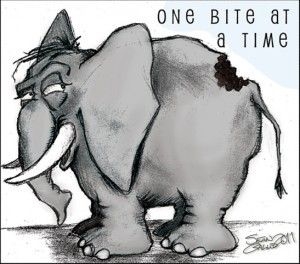The Joy of Small Lots & Orders
Applying the Theory of Constraints to a Distribution Center, Part 4
In the  previous article, I discussed the problem at a distribution center that picked orders with floor pickers and reach trucks. The DC fell behind demand, and orders shipped later and later. The season for the company exploded early, and demand grew faster and higher than expected. This is a great problem to have—except when throughput drops. Orders backed up, and then orders became past due. The backlog became deep enough that many customers had multiple past-due orders.
previous article, I discussed the problem at a distribution center that picked orders with floor pickers and reach trucks. The DC fell behind demand, and orders shipped later and later. The season for the company exploded early, and demand grew faster and higher than expected. This is a great problem to have—except when throughput drops. Orders backed up, and then orders became past due. The backlog became deep enough that many customers had multiple past-due orders.
A problem became an opportunity—or so the sales and DC management teams thought. The idea: combine the multiple past-due and current orders into a single bigger order by customer. The larger order (batch size) would be more productive, and the DC could blow through the orders faster.
How did that work for them? In a word, badly. The bigger orders took longer to pick and longer to label, which stretched out the order cycle time to days. Combining the orders did not address the aisle congestion or the tendency of the pickers to cherry-pick the orders they wanted to do. So the pre-label staging area grew and spilled over into another area.
Worse, the lag time between order print, pick, and label made self-auditing difficult and prevented accountability. The partially picked orders marinated in the staging areas longer, and with the influx of more pallets of picked partial orders, pallets of picked products disappeared into the sea of staging. Coordinators attempted to keep things organized, but with nobody holding the pickers accountable for working orders in sequence, for picking orders accurately, or for recording where they put the pallets of partial orders, things got lost. When the coordinator could not find part of an order and the system showed the pick confirmed complete, they would kill that part of the order, sending the goods back to stock in the system, and create a new pick order.
The rework added to the confusion. When the coordinators found a lost pallet, they moved the pallet over to yet another staging area, the boneyard, where it sat waiting to be put back into stock. Sometimes the new order created a demand for more labels to be printed—labels that had already been printed, but with no systematic process for controlling the print.
Combining the orders proved to be a mistake that choked off throughput, driving more customer orders to become past due as small orders waited behind the bulge of the big combined orders. This was an example of the cure being worse than the disease. Once done, the DC had to work through the bigger orders for conditions to improve. Management learned an important lesson about the mirage of large-order productivity, and how it can be detrimental to throughput. While management focused on pressing the big lump through the snake, they did not make a critical examination of the root causes of the real backlog, the inherent disconnection between fork and floor picking.
 The pickers worked as one big team. The problem was, they really were not a functioning team. With no leader, there was no focus. Without supervisory control over the order start sequence, the orders did not pick together. The idea that the orders would flow back together in pre-label staging did not work because too many pickers started too many orders. Without a supervisor to hold the pickers accountable for completing orders and picking the orders without defect, the coordinators fought a losing battle to consolidate the orders before labeling.
The pickers worked as one big team. The problem was, they really were not a functioning team. With no leader, there was no focus. Without supervisory control over the order start sequence, the orders did not pick together. The idea that the orders would flow back together in pre-label staging did not work because too many pickers started too many orders. Without a supervisor to hold the pickers accountable for completing orders and picking the orders without defect, the coordinators fought a losing battle to consolidate the orders before labeling.
The first move: break the picking team down into smaller units, teams of two or three who would be held accountable for completing an order. We paired floor pickers and fork pickers together in two-person teams. They started the same order and shared the responsibility for completing the order together. If the floor picker completed their work first, they helped the fork picker complete that part of the order. Only after completing the order together and auditing the order to assure accuracy could the team move to the next order.
Each picking team served a dedicated label table. This way, the tables knew their pickers, so when they found an error, they could go to the responsible picker to correct the work. Since the picking teams fed the picked product directly to the label lanes, the orders were processed in the same day, not days apart as had previously been the case.
With these changes, the backlog of marinating orders shrunk down to nothing. Accountability for accuracy on the part of the pickers improved, and rework dropped. As measured by lines shipped, throughput quickly shifted, and more lines shipped per day than were picked, as the DC worked through different piles of WIP inventory.


